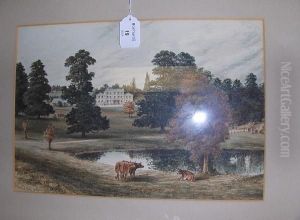Edward, Rev. Bradley Paintings
The Reverend Edward Bradley, better known under his pseudonym Cuthbert Bede, was a 19th-century English clergyman and writer, rather than a traditional visual artist. Born on March 25, 1827, in Kidderminster, Worcestershire, Bradley was the son of a solicitor. He attended Durham University where he graduated with a Master of Arts. After his education, he pursued a career in the Anglican Church, serving various parishes throughout his life.
Bradley's contributions to art history are not found in paintings or sculptures, but rather in his literary works, particularly his humorous novel 'The Adventures of Mr. Verdant Green, an Oxford Freshman'. Illustrated by the author himself, the book contained numerous illustrations that were quite popular and showcased his talent for drawing and caricature. The novel was serialized at first and published in book form in 1853. It became something of a cult classic among Oxford students for generations.
As an author, Bradley was prolific, writing a range of other books and essays, many of which also included his illustrations. His works often reflected his keen sense of humor and satirical eye, frequently targeting academic and clerical life. Despite the success of his literary endeavors, Bradley never strayed far from his clerical duties, balancing his time between writing and his obligations to the Church.
Bradley's illustrations, while not revolutionary in the artistic sense, contributed to the Victorian era's culture and are remembered for their charm and wit. His use of the pseudonym 'Cuthbert Bede' was a playful take on his academic background – 'Cuthbert' being a saint associated with Durham University and 'Bede' a reference to the Venerable Bede, an early English church historian and scholar.
Throughout his life, Bradley was respected for his dual role as clergyman and author. He died on December 12, 1889. Although his name is not commonly recognized among the pantheon of great artists, his work remains a delightful window into Victorian life and humor, and his illustrations continue to be appreciated for their historical and cultural significance.

